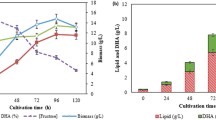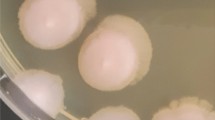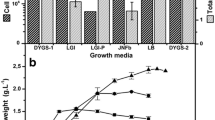Abstract
Culture conditions for pullulan production by Aureobasidium pullulans were optimized using response surface methodology at shake flask level without pH control. In the present investigation, a five-level with five-factor central composite rotatable design of experiments was employed to optimize the levels of five factors significantly affecting the pullulan production, biomass production, and sugar utilization in submerged cultivation. The selected factors included concentration of sucrose, ammonium sulphate, yeast extract, dipotassium hydrogen phosphate, and sodium chloride. Using this methodology, the optimal values for concentration of sucrose, ammonium sulphate, yeast extract, dipotassium hydrogen phosphate, and sodium chloride were 5.31%, 0.11%, 0.07%, 0.05%, and 0.15% (w/v), respectively. This optimized medium has projected a theoretically production of pullulan of 4.44%, biomass yield of 1.03%, and sugar utilization of 97.12%. The multiple correlation coefficient ‘R’ was 0.9976, 0.9761 and 0.9919 for pullulan production, biomass production, and sugar utilization, respectively. The value of R being very close to one justifies an excellent correlation between the predicted and the experimental data.
Similar content being viewed by others
Explore related subjects
Discover the latest articles, news and stories from top researchers in related subjects.Avoid common mistakes on your manuscript.
Introduction
Pullulan is an extracellular water-soluble homopolysaccharide produced by a yeast-like fungus Aureobasidium pullulans. It is usually described as an α-(1→6) linked linear polymer of maltotriose subunits [1]. Besides A. pullulans, Rhodotorula bacarum has also been reported to produce a large amount of melanin-free pullulan [2]. Recently, Forabosco et al. [3] reported that pullulan is also produced by Cryphonectria parasitica, which is a fungal agent of chestnut blight. Some distinctive properties of pullulan, such as structure flexibility, enhanced water-solubility, and excellent film- and fiber-forming properties, are attributed to regular alternation of α-(1→4) and α-(1→6) linkages in the ratio of 2:1 [4]. Pullulan has been produced commercially for about 30 years and currently sold at US $2,000/kg (Sigma, USA), which is too high for many of its potential applications. Nowadays, pullulan has been gaining attention as an excellent material for food and pharmaceutical and biomedical applications. Pullulan is edible and biodegradable, which makes it a very useful and attractive material. It is usually used as a low-calorie food additive, oxygen impermeable film for packaging, adhesives, and thickening and extending agents [1, 5].
The high price of pullulan is due to the difficulties in its production, such as high broth viscosity, low product yield, and pigment production. Because of the potential uses of pullulan, the need exists for the development of a low-cost industrial media formulation. In this respect, the response surface methodology, which is used to study the effects of several factors influencing the responses by varying them simultaneously and carrying out a limited number of experiments, is very productive. The optimization of medium components by classical methods involving the change of one variable at a time is extremely time consuming and expensive when a large number of variables are considered. This method does not bring about the effects of interaction of various parameters [6]. To overcome these difficulties, response surface methodology (RSM) is employed to optimize the medium components [7, 8]. RSM is an important tool to study the effect of both the primary factors and their mutual interactions on pullulan production [9]. Central composite rotatable design (CCRD) is a widely used statistical technique for determining the key factors from a large number of medium components by a small number of experiments. Experimental designs for optimization have been commonly used for the optimization of multiple variables with minimum number of experiments [10, 11]. RSM has been extensively used in many areas of biotechnology for optimal production of sorbitol [12], xylitol [13], lactic acid [14], chitinase enzyme [15], chitosan [16], citric acid [17], and ethanol production [18]. A two-level factorial design for A. pullulans batch cultivations to improve the production and molecular weight of exopolysaccharide has been reported [19]. In a stirred tank reactor, optimization of pullulan production by A. pullulans using response surface methodology has also been reported [20].
In the present study, optimization of pullulan production by A. pullulans in batch experiments was attempted using central composite rotatable design, where the simultaneous effect of five independent variables (sucrose, ammonium sulphate, yeast extract, dipotassium hydrogen phosphate, and sodium chloride) were investigated for optimum pullulan and biomass production. The literature survey reveals that it is a new report for the production of pullulan using central composite rotatable design at shake flask level.
Materials and Methods
Microorganism
A. pullulans FB-1, an isolate of our laboratory, was used for the present work. The culture has been isolated, identified, and maintained as described earlier [21]. It has been deposited in Microbial Type Culture Collection (MTCC), Chandigarh, India and assigned accession no. MTCC 6994.
Medium and Culture Conditions
Inoculum was prepared in a medium (50 mL) containing (g/L) sucrose 50.0, K2HPO4 2.0, (NH4)2SO4 1.0, NaCl 0.5, MgSO4·7H2O 0.05, FeSO4 0.01, MnSO4 0.01, ZnSO4 0.01, and pH 7.0 at 30°C on a refrigerated rotary shaker (Innova 4335, New Brunswick Scientific, USA) under agitation (150 rpm) for 4 days. Inoculum (5%, v/v) was transferred to the production medium (50 mL) containing (g/L) sucrose 50.0, K2HPO4 5.0, NaCl 1.0, MgSO4·7H2O 0.2, yeast extract 2.0, and adjusted to pH 6.5. After inoculation, Erlenmeyer flasks were incubated at 30°C on a refrigerated rotary shaker at 150 rpm for 7 days.
Experimental Design and Statistical Analysis
A central composite rotatable design [6] with five variables was used to study the response patterns and to determine the optimum combination of the variables. The variables optimized were sucrose (1.36–8.64%, w/v), (NH4)2SO4 (0.02–0.24%, w/v), yeast extract (0.01–0.15%, w/v), K2HPO4 (0.02–0.10%, w/v), and NaCl (0.01–0.24%, w/v) each at five levels, i.e., −1.821, −1.000, 0.000, 1.000, and 1.821 (Table 1). Pullulan production, biomass production, and sugar utilization after 7 days of fermentation were studied as responses, as there was no significant increase in either of the responses after this time. This criterion was used in all experiment designs. The statistical analysis of the results was performed with the aid of Design Expert ver. 7.0.3 statistical software (Stat-Ease Inc., Minneapolis, MN, USA). The pullulan production, biomass production, and sugar utilization were analyzed using the analysis of variance (ANOVA) combined with the Fisher test to evaluate if a given term possess a significant effect (P ≤ 0.05). The optimum levels of the variables were obtained by graphical and numerical analysis using Design Expert program.
Analytical Techniques
Determination of Biomass
A sample of the culture broth (10 mL), diluted 2-fold with deionized water, was centrifuged at 2,500×g for 10 min. The sedimented cells were then washed twice with deionized water and dried to a constant weight at 80°C. Biomass (%) was estimated as grams of biomass (dry weight) produced per 100 mL of fermented broth.
Determination of Exopolysaccharide
The exopolysaccharide (pullulan) was precipitated from the supernatant by addition of two volumes of isopropyl alcohol and allowed to stand overnight at 4°C. The precipitates were separated by centrifugation (2,500×g, 10 min), washed with alcohol, and then dried to a constant weight at 80°C. Exopolysaccharide (%) was estimated as grams of pullulan (dry weight) produced per 100 mL of fermented broth.
Determination of Total Sugars
Total sugars were estimated according to the phenol sulphuric acid method using sucrose as standard [22].
Results and Discussion
Using the CCRD, a total of 27 experiments with appropriate combinations of sucrose, (NH4)2SO4, yeast extract, K2HPO4, and NaCl were conducted. A central composite design with five coded levels for all the five factors: sucrose (A), (NH4)2SO4 (B), yeast extract (C), K2HPO4 (D), and NaCl (E) were used for this purpose. The range of the variables is given in Table 1. The experimental design and the results obtained for pullulan production, biomass production, and sugar utilization are presented in Table 2. The experimental results of the CCD were fitted with a second order polynomial equation. The values of regression coefficients were calculated, and the fitted equations (in terms of coded values) for predicting pullulan production (X), biomass production (Y), and sugar utilization (Z) were as given below regardless of the significance of the coefficients:
where A is sucrose concentration; B, (NH4)2SO4 concentration; C, yeast extract concentration; D, K2HPO4 concentration; and E, NaCl concentration. The statistical significance of Eqs. 1–3 was checked by ANOVA for response surface quadratic model and is summarized in Table 3. Data in the Table 3 indicate that the model is highly significant. It is further confirmed from a very low probability value for pullulan and biomass production and sugar utilization (P model < 0.05). The P values suggest the significance of each coefficient, which in turn may indicate the pattern of the interaction between the coefficients. The smaller the P value, the more significant is the corresponding coefficient [23]. The multiple correlation coefficient R is 0.9976, 0.9761, and 0.9919 for pullulan production, biomass production, and sugar utilization, respectively, which is very close to one and justifies an excellent correlation between the predicted and experimental values. The coefficient estimates of Eqs. 1–3 are presented in Table 4. The model F values of 102.18 for pullulan production, 10.22 for biomass production, and 30.50 for sugar utilization imply that the model is significant.
The quadratic model in Eqs. 1–3 with 20 terms contain five linear, five quadratic terms, and ten two-factorial interactions. Out of these, insignificant terms (on the basis of P values, which are more than 0.1000 for each response) are neglected (Table 3). Thus, the model Eqs. 1–3 are modified to reduced fitted model Eqs. 4–6:
Pullulan production, biomass production, and sugar utilization, as predicted by the final quadratic model along with the corresponding observed values, are given in Table 5. Comparison of these values indicated that there is an excellent agreement between the predicted and experimental data. The location of optimum, obtained by differentiation of the quadratic model, for achieving maximum pullulan production, biomass production, and sugar utilization was A = 5.31, B = 0.11, C = 0.07, D = 0.05, and E = 0.15. The predicted optimal pullulan production, biomass production and sugar utilization corresponding to these values were 4.44%, 1.03% and 97.12%, respectively. To confirm the accuracy of the model for predicting maximum pullulan production, biomass production, and sugar utilization, additional experiments in triplicates using these optimized medium components were performed. These triplicate experiments yielded an average maximum pullulan, biomass, and sugar utilization of 4.42%, 1.00%, and 96.87%, respectively. The good agreement between the predicted and experimental values verifies the validity of the model as well as the existence of optimal point.
The response surfaces based on the final model are depicted in the Fig. 1, which were obtained by holding three variables at their optimum level while varying the other two within their experimental range. It is clear from Fig. 1 that the minimum response of pullulan production (2.10%), biomass (0.76%), and sugar utilization (69.70%) occurred when sucrose was at its lowest level. Pullulan production, biomass production, and sugar utilization has been increased considerably as the concentration of sucrose was increased in the media, which indicates that the sucrose concentration in the media formulation for pullulan production has a significant effect on the responses. As the sucrose concentration was increased, the responses were maximum nearly at the middle of the (NH4)2SO4 concentration. Beyond 5.00% (w/v) sucrose concentration, pullulan production was decreased due to inhibition caused by high sugar concentration. Shin et al. [24] found that pullulan production was inhibited at high initial sucrose concentration and were of the opinion that the yields could be increased by using fed-batch fermentation. Lazaridou et al. [25] has also reported that pullulan production increases with the increase of initial sugar concentration from 5.00% to 10.00% (w/v). The decline in pullulan production at high sugar concentrations may be due to osmotic effects and a low water activity. It has been reported by Shin et al. [26] that (NH4)2SO4 contributes to the decrease of pH of the culture broth as well as cell growth, but yeast extract mainly contributes to the cell growth without the significant decrease of pH of the culture broth.
a–f Response surfaces showing the effect of sucrose, (NH4)2SO4, and K2HPO4 on pullulan production, biomass production, and sugar utilization (when the effect of two variables were plotted, keeping the other three at their middle-level values, i.e., 5.00% sucrose, 0.15% (NH4)2SO4, 0.08% yeast extract, 0.06% K2HPO4, and 0.13% NaCl)
The response was also varied at different levels of K2HPO4 along the axis, suggesting that there is a considerable interaction between sucrose and K2HPO4. The response surfaces shown in Fig. 1b,d, and f depict the combined effect of sucrose and K2HPO4 concentration in the media on pullulan production, biomass production, and sugar utilization. A significant increase in pullulan concentration with the supplementation of K2HPO4 in the fermentation medium has been reported by Shabtai and Mukmeneev [27]. The response surfaces shown in Fig. 2a and b shows the effect of varying NaCl concentration on pullulan and biomass production. It has been found that NaCl has a positive effect on the pullulan production and a slight adverse effect on the growth. Similar results have been reported by Boa and LeDuy [28]. Response surface optimization supported 4.44% production of pullulan by A. pullulans FB-1. In comparison, only 1.72% [20] and 2.26% [19] pullulan production has been reported using RSM. This shows a significant increase in pullulan production using a statistical technique.
Conclusions
Statistical optimization of fermentation medium could overcome the limitations of classical empirical methods. It was proved to be a powerful tool for the optimization of the pullulan production, biomass production, and sugar utilization by A. pullulans FB-1. Response surface methodology was proposed to study the combined effects of culture medium components. The existence of interactions between the independent variables with the responses was observed. The optimum media has the following composition (%, w/v): sucrose 5.31, (NH4)2SO4 0.11, yeast extract 0.07, K2HPO4 0.05, and NaCl 0.15. Validation experiments were performed to verify the accuracy of the models, and the results showed that the experimental values agreed with the predicted values well.
References
Leathers, T. D. (2003). Applied Microbiology and Biotechnology, 62, 468–473.
Chi, Z., & Zhao, S. (2003). Enzyme and Microbial Technology, 33, 206–211.
Forabosco, A., Bruno, G., Sparapano, L., Liut, G., Marino, D., & Delbren, F. (2006). Carbohydrate Polymers, 63, 535–544.
Lee, J.-H., Kim, J.-H., Zhu, I.-H., Zhan, X.-B., Lee, J.-W., Shin, D.-H., et al. (2001). Biotechnology Letters, 23, 817–820.
Shingel, K. I. (2004). Carbohydrate Research, 339, 447–460.
Cochran, W. G., & Cox, G. M. (1992). In experimental designs. New York, USA: Wiley.
Balusu, R., Paduru, R. R., Kuravi, S. K., Seenayya, G., & Reddy, G. (2005). Process Biochemistry, 40, 3025–3030.
Raoa, Y. K., Lub, S.-C., Liub, B.-L., & Tzeng, Y.-M. (2006). Biochemical Engineering Journal, 28, 57–66.
Box, G. E. P., Hunter, W. G., & Hunter, J. G. (1978). In statistics of experimenters. New York, USA: Wiley.
Montgomery, D. C. (2001). In design and analysis of experiments. New York, USA: Wiley.
Kalil, S. J., Maugeri, F., & Rodrigues, M. I. (2000). Process Biochemistry, 35, 539–550.
Cazetta, M. L., Celligoi, M. A. P. C., Buzato, J. B., Scarmino, I. S., & Silva, R. S. F. (2005). Process Biochemistry, 40, 747–751.
Faveri, D. D., Torre, P., Perego, P., & Converti, A. (2004). Journal of Food Engineering, 65, 383–389.
Kotzamanidis, C., Roukas, T., & Skaracis, G. (2002). World Journal of Microbiology & Biotechnology, 18, 441–448.
Nawani, N. N., & Kapadnis, B. P. (2005). Process Biochemistry, 40, 651–660.
Göksungur, Y. (2004). Journal of Chemical Technology and Biotechnology, 79, 974–981.
Li, C., Bai, J., Cai, Z., & Ouyang, F. (2002). Journal of Biotechnology, 93, 27–34.
Sreekumar, O., Chand, N., & Basappa, S. C. (1999). Journal of Bioscience and Bioengineering, 88, 334–338.
Lin, Y., Zhang, Z., & Thibault, J. (2007). Process Biochemistry, 42, 820–827.
Göksungur, Y., Dağbağli, S., Uçan, A., & Güvenç, U. (2005). Journal of Chemical Technology and Biotechnology, 80, 819–827.
Singh, R. S., & Saini, G. K. (2008). Bioresource Technology, 99, 3896–3899.
Dubois, M., Gilles, K. A., Hamilton, J. K., Rebers, P. A., & Smith, F. (1956). Analytical Chemistry, 28, 350–356.
Rao, K. J., Kim, C. H., & Rhee, S. K. (2000). Process Biochemistry, 35, 639–647.
Shin, C. Y., Kim, Y. H., Lee, H. S., Kim, Y. N., & Byun, S. M. (1987). Biotechnology Letters, 9, 621–624.
Lazaridou, A., Biliaderis, C. G., Roukas, T., & Izydorczyk, M. (2002). Applied Biochemistry and Biotechnology, 97, 1–22.
Shin, Y. C., Kim, Y. H., Lee, H. S., Cho, S. J., & Byun, S. M. (1989). Biotechnology and Bioengineering, 33, 129–133.
Shabtai, Y., & Mukmeneev, I. (1995). Applied Microbiology and Biotechnology, 43, 595–603.
Boa, J. M., & LeDuy, A. (1984). Applied and Environmental Microbiology, 48, 26–30.
Acknowledgments
Authors are thankful to the Department of Biotechnology, Punjabi University, Patiala for providing the necessary laboratory facilities for this work. The financial assistance received under the FIST program from Department of Science and Technology, Govt. of India, New Delhi is duly acknowledged.
Author information
Authors and Affiliations
Corresponding author
Rights and permissions
About this article
Cite this article
Singh, R.S., Singh, H. & Saini, G.K. Response Surface Optimization of the Critical Medium Components for Pullulan Production by Aureobasidium pullulans FB-1. Appl Biochem Biotechnol 152, 42–53 (2009). https://doi.org/10.1007/s12010-008-8180-9
Received:
Accepted:
Published:
Issue Date:
DOI: https://doi.org/10.1007/s12010-008-8180-9






